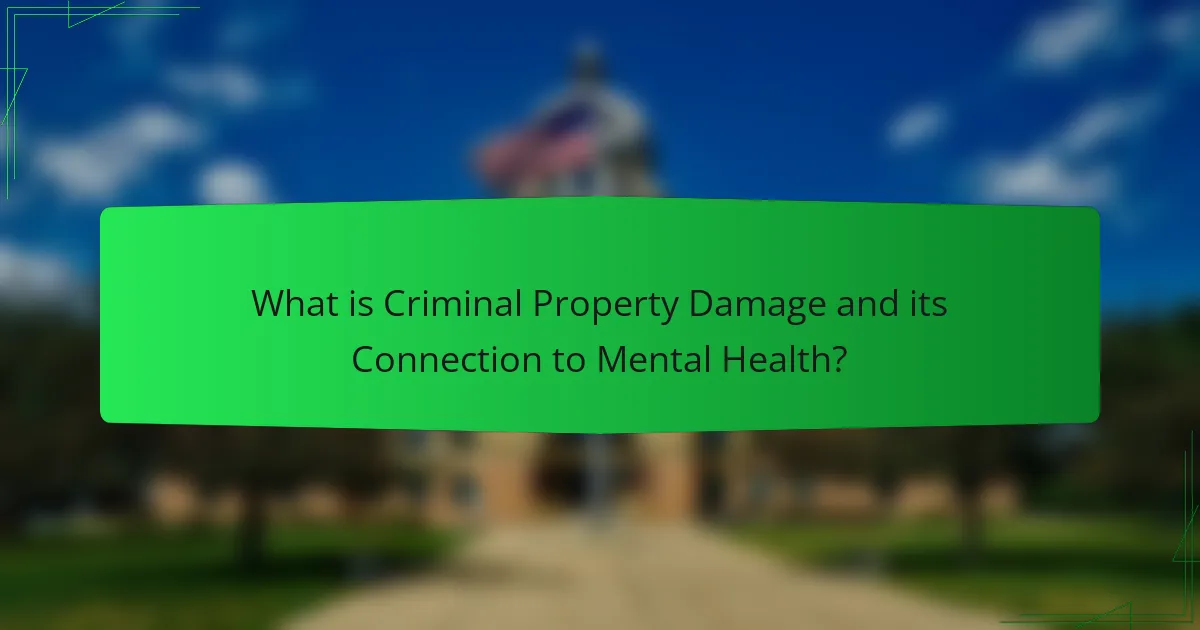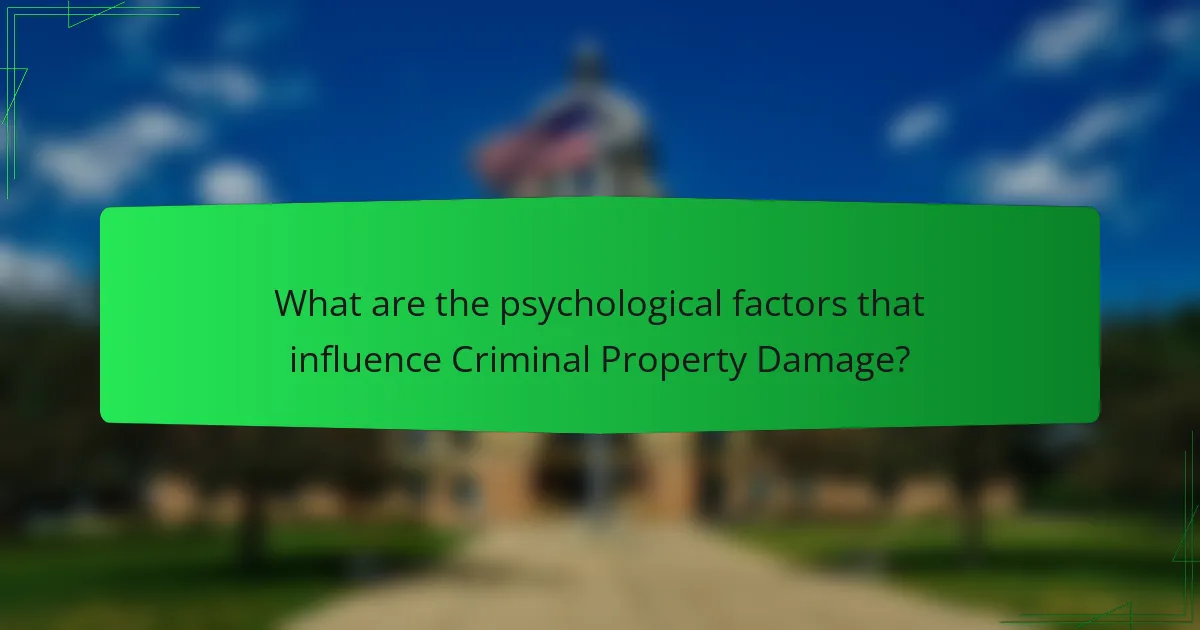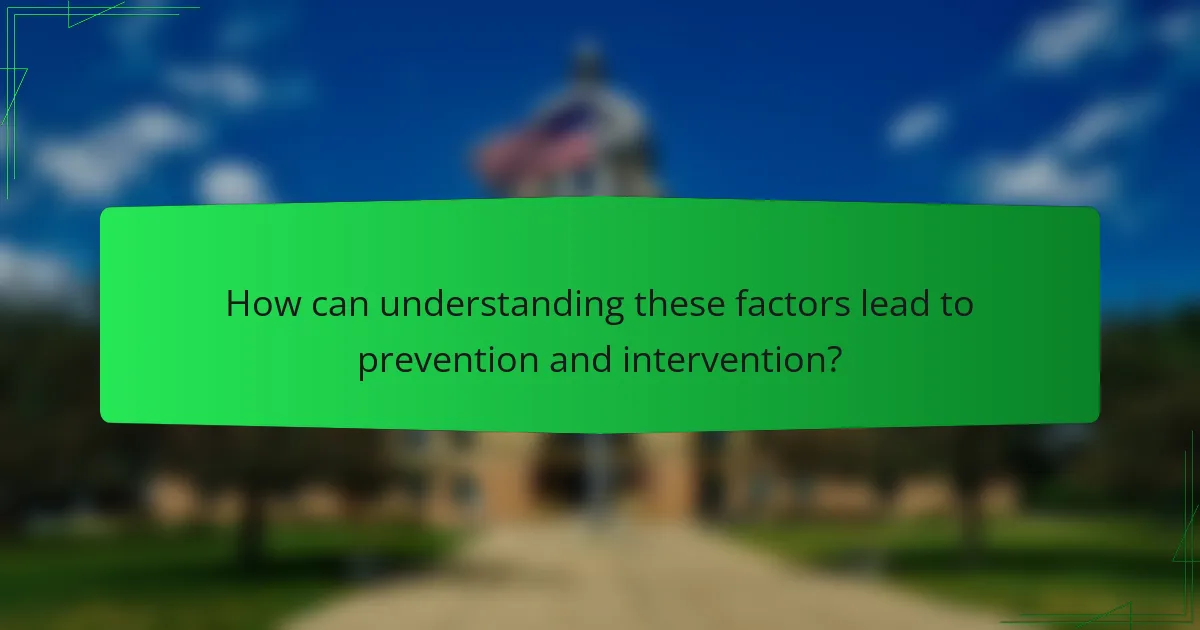Criminal property damage is the intentional destruction or defacement of someone else’s property, encompassing acts such as vandalism and graffiti. This behavior is often linked to underlying mental health issues, including impulse control problems, aggression, and emotional distress. Research highlights that a significant proportion of offenders have mental health diagnoses, such as anxiety or depression, suggesting that addressing these issues can help reduce property damage incidents. Psychological factors, including anger and social influences, play a critical role in these behaviors, indicating the need for targeted prevention and intervention strategies that incorporate mental health support. Understanding these connections is essential for developing effective community programs and improving law enforcement responses to such crimes.

What is Criminal Property Damage and its Connection to Mental Health?
Criminal property damage refers to the intentional destruction or defacement of someone else’s property. It can involve vandalism, graffiti, or breaking and entering. This type of crime is often linked to underlying mental health issues. Individuals committing such acts may struggle with impulse control, aggression, or emotional distress. Research indicates that a significant percentage of offenders have mental health diagnoses, such as anxiety or depression. The connection suggests that addressing mental health can reduce instances of property damage. Understanding these psychological factors is crucial for effective prevention and intervention strategies.
How does Criminal Property Damage manifest in society?
Criminal property damage manifests in society through various forms of vandalism, destruction of property, and graffiti. These actions lead to significant economic costs, with estimates suggesting billions of dollars in damages annually. Communities often experience heightened fear and insecurity as a result of such incidents. Property damage can also lead to decreased property values in affected areas. Social cohesion may diminish as residents feel less safe and more distrustful of one another. Additionally, the psychological impact on victims can include feelings of violation and anxiety. Law enforcement agencies report that property crimes are among the most common offenses, indicating their prevalence in society. Overall, criminal property damage has both immediate and long-term effects on communities and individuals.
What are the common forms of Criminal Property Damage?
Common forms of criminal property damage include vandalism, arson, and graffiti. Vandalism typically involves the intentional destruction or defacement of property. This can include breaking windows or damaging vehicles. Arson refers to the deliberate setting of fire to property, causing extensive damage. Graffiti involves the unauthorized marking of surfaces with paint or other materials. Each of these acts results in financial loss and emotional distress for victims. According to the FBI, property crimes, which include these forms, accounted for over $15 billion in losses in 2020.
What are the underlying motivations behind committing Criminal Property Damage?
The underlying motivations behind committing Criminal Property Damage include anger, frustration, and a desire for control. Individuals may act out destructively due to unresolved emotional issues. Research indicates that some offenders may seek to express their feelings or retaliate against perceived injustices. Additionally, social and economic factors can play a role. For instance, individuals facing financial stress may vandalize as a form of coping or protest. A study by the National Institute of Justice found that psychological distress is often linked to property crime behaviors. Understanding these motivations can help in developing prevention strategies.
Why is understanding the psychological factors involved in Criminal Property Damage important?
Understanding the psychological factors involved in criminal property damage is crucial for effective intervention. These factors can reveal underlying motivations and triggers for such behaviors. Recognizing these elements aids law enforcement and mental health professionals in developing targeted prevention strategies. Research indicates that psychological distress often correlates with property damage incidents. For instance, studies show that individuals with unresolved trauma may exhibit destructive behaviors. Addressing these psychological issues can reduce recidivism rates and improve community safety. Understanding these factors ultimately leads to more informed legal and therapeutic approaches.
How do mental health issues contribute to Criminal Property Damage?
Mental health issues can lead to criminal property damage through impaired judgment and emotional instability. Individuals with conditions such as schizophrenia or severe depression may act impulsively. This impulsivity can result in destructive behaviors, including vandalism or damage to property.
Research indicates that individuals with untreated mental health disorders are more likely to engage in criminal activities. According to a report from the National Institute of Mental Health, about 20% of individuals with severe mental illness have committed property crimes.
Moreover, substance abuse often co-occurs with mental health issues. This combination can exacerbate aggressive behaviors, increasing the likelihood of property damage. Understanding these connections is crucial for developing effective interventions.
What role does societal influence play in the psychological aspects of Criminal Property Damage?
Societal influence significantly impacts the psychological aspects of Criminal Property Damage. Social norms and values shape individuals’ perceptions of acceptable behavior. When society normalizes aggression or vandalism, individuals may feel justified in committing property damage. Peer pressure can also lead individuals to engage in such acts to fit in or gain acceptance. Additionally, socioeconomic factors play a role; communities with higher poverty rates may experience increased property damage due to frustration and lack of resources. Research indicates that societal disorganization correlates with higher crime rates, including property damage. Understanding these influences is crucial for developing effective prevention strategies.

What are the psychological factors that influence Criminal Property Damage?
Psychological factors influencing criminal property damage include anger, frustration, and a desire for control. Individuals may engage in property damage as an expression of unresolved emotional issues. Studies show that those with low impulse control are more likely to commit such acts. Additionally, social influences can play a significant role. Peer pressure and group dynamics often encourage destructive behaviors. Mental health conditions, such as conduct disorder or antisocial personality disorder, can also predispose individuals to property damage. Research indicates that environmental stressors, like poverty or exposure to violence, contribute to these behaviors. Understanding these psychological factors is crucial for prevention and intervention strategies.
How do emotions affect the likelihood of committing Criminal Property Damage?
Emotions significantly influence the likelihood of committing Criminal Property Damage. Intense emotions like anger, frustration, or jealousy can lead individuals to act impulsively. Research indicates that individuals experiencing high levels of negative emotions are more prone to engage in destructive behaviors. For instance, a study published in the Journal of Criminal Justice found that emotional dysregulation correlates with increased property offenses. Furthermore, feelings of perceived injustice often trigger retaliatory actions, including vandalism. Such emotional responses can diminish rational decision-making capabilities, making property damage more likely.
What emotional triggers are commonly associated with Criminal Property Damage?
Common emotional triggers associated with criminal property damage include anger, fear, and frustration. Anger often arises from feelings of violation or injustice. Fear can stem from concerns about safety and security in one’s environment. Frustration may develop due to the disruption of normalcy and the emotional toll of dealing with the aftermath. Additionally, feelings of helplessness can emerge when individuals feel powerless to prevent such incidents. These emotional responses can significantly impact mental health, leading to anxiety and stress. Studies indicate that victims of property damage often experience a range of emotional distress, highlighting the psychological effects of such events.
How can anger and frustration lead to Criminal Property Damage?
Anger and frustration can lead to criminal property damage through impulsive actions. When individuals experience intense emotions, they may lose control and act destructively. This destructive behavior can manifest as vandalism or destruction of personal or public property. Research shows that heightened emotional states can impair judgment and increase aggression. For instance, a study published in the Journal of Criminal Justice found a correlation between unmanaged anger and increased likelihood of property crimes. Additionally, frustration can create feelings of helplessness, prompting individuals to lash out at their surroundings. Thus, the psychological response to anger and frustration often results in harmful actions toward property.
What mental health disorders are commonly linked to Criminal Property Damage?
Mental health disorders commonly linked to criminal property damage include antisocial personality disorder, conduct disorder, and intermittent explosive disorder. Antisocial personality disorder is characterized by a disregard for the law and the rights of others. Individuals with this disorder may engage in destructive behaviors, including property damage. Conduct disorder, often diagnosed in children and adolescents, involves a pattern of violating societal norms and rules, which can manifest as vandalism or destruction of property. Intermittent explosive disorder involves recurrent outbursts of aggression, leading to property damage during episodes of rage. Research indicates that these disorders can contribute to impulsive and aggressive behaviors that result in criminal property damage.
How does conduct disorder relate to Criminal Property Damage?
Conduct disorder is a mental health condition characterized by a pattern of disruptive and violent behavior. Individuals with conduct disorder may engage in activities that result in criminal property damage. This includes vandalism, destruction of property, and other illegal actions. Research indicates that children and adolescents with conduct disorder are at a higher risk for engaging in such behaviors. According to the American Psychiatric Association, these behaviors often stem from underlying issues such as aggression and a lack of empathy. Thus, the relationship between conduct disorder and criminal property damage is significant, as the disorder often leads to acts that harm others’ property.
What is the connection between antisocial personality disorder and Criminal Property Damage?
Antisocial personality disorder (ASPD) is linked to criminal property damage due to impulsive and reckless behaviors. Individuals with ASPD often exhibit a disregard for societal norms and the rights of others. This can manifest in actions such as vandalism or destruction of property. Research indicates that individuals with ASPD are more prone to engage in criminal activities. A study published in the Journal of Abnormal Psychology found that those with ASPD had higher rates of property offenses compared to the general population. The impulsivity and lack of remorse associated with ASPD contribute significantly to these behaviors.

How can understanding these factors lead to prevention and intervention?
Understanding the psychological factors involved in criminal property damage can lead to effective prevention and intervention strategies. By identifying underlying mental health issues, stakeholders can implement targeted support systems. For instance, early intervention programs can address behavioral issues before they escalate. Research indicates that addressing mental health can reduce recidivism rates significantly. Studies show that individuals with mental health support are less likely to engage in criminal activities. This understanding allows for the development of community programs tailored to at-risk populations. Additionally, educating law enforcement on mental health can improve responses to incidents. Overall, understanding these factors facilitates a proactive approach to reducing criminal property damage.
What strategies can be employed to prevent Criminal Property Damage?
Implementing security measures is crucial to prevent criminal property damage. Installing surveillance cameras deters potential offenders. Adequate lighting around properties reduces hiding spots for criminals. Engaging with local law enforcement enhances community safety. Neighborhood watch programs foster vigilance among residents. Regular property maintenance signals that a space is occupied and cared for. Educating the public about the consequences of property damage raises awareness. Studies show that visible security measures can lower crime rates significantly.
How can mental health support reduce the incidence of Criminal Property Damage?
Mental health support can significantly reduce the incidence of criminal property damage. Effective mental health interventions address underlying psychological issues that may lead to destructive behaviors. Individuals with mental health support are less likely to act out in anger or frustration. Studies indicate that access to mental health services decreases aggressive behaviors among at-risk populations. For instance, a 2018 study by the National Institute of Mental Health found that individuals receiving therapy showed a 30% reduction in violent incidents. Furthermore, community mental health programs foster social skills and coping mechanisms. Improved emotional regulation leads to better decision-making and reduced impulsivity. Overall, mental health support creates a safer environment, lowering the likelihood of property damage.
What community programs are effective in addressing the psychological factors of Criminal Property Damage?
Restorative justice programs are effective in addressing the psychological factors of Criminal Property Damage. These programs focus on repairing harm through dialogue between offenders and victims. They encourage empathy and understanding, which can reduce recidivism. Community-based mental health services also play a crucial role. They provide support for underlying issues such as trauma and anger management. Additionally, youth engagement programs, like mentorship initiatives, help at-risk individuals develop positive coping strategies. Studies indicate that these programs lead to lower rates of property damage incidents. Involving community members fosters a sense of responsibility and collective healing.
What are the best practices for addressing Criminal Property Damage in communities?
Implementing community engagement initiatives is a best practice for addressing criminal property damage. These initiatives foster collaboration between residents and law enforcement. Encouraging neighborhood watch programs enhances vigilance and reporting of suspicious activities. Establishing clear communication channels allows residents to voice concerns effectively.
Promoting educational workshops on property safety empowers residents with knowledge. Installing surveillance cameras can act as a deterrent against vandalism. Regular maintenance of public spaces reduces opportunities for damage. Collaborating with local businesses can enhance community investment in safety measures.
Research indicates that proactive community involvement reduces crime rates. A study by the National Institute of Justice found that community policing strategies effectively lower property crime incidents. These practices create a safer environment and strengthen community ties.
How can law enforcement collaborate with mental health professionals?
Law enforcement can collaborate with mental health professionals through integrated crisis response teams. These teams combine police officers and mental health experts to address incidents involving individuals in mental health crises. They provide immediate support and intervention, reducing the likelihood of escalation. Research shows that such collaborations can lead to better outcomes for individuals experiencing crises. A study by the National Alliance on Mental Illness found that these teams can lower arrest rates and improve access to mental health services. Additionally, training programs for officers on mental health awareness can enhance understanding and communication. This collaboration ultimately fosters a more effective and compassionate approach to law enforcement.
What role do educational initiatives play in mitigating Criminal Property Damage?
Educational initiatives play a crucial role in mitigating criminal property damage. They raise awareness about the consequences of such actions. Programs often target at-risk youth to deter them from engaging in criminal behavior. Education fosters empathy and understanding of the impact on victims. Studies show that well-structured educational campaigns can reduce crime rates significantly. For example, a report by the National Institute of Justice found that community education initiatives decreased vandalism by 30% in targeted areas. By informing individuals about legal repercussions, educational initiatives discourage property damage. Overall, education serves as a preventive measure against criminal behavior.
Criminal property damage refers to the intentional destruction or defacement of another person’s property, often linked to underlying mental health issues such as impulse control and emotional distress. The article explores various forms of property damage, including vandalism and arson, and highlights the significant economic and psychological impacts on communities. It delves into the motivations behind these behaviors, emphasizing the role of emotions and mental health disorders like antisocial personality disorder and conduct disorder. Additionally, the article discusses effective prevention strategies, including mental health support and community engagement initiatives, aimed at reducing the incidence of criminal property damage. Understanding these psychological factors is crucial for developing targeted interventions and fostering safer communities.